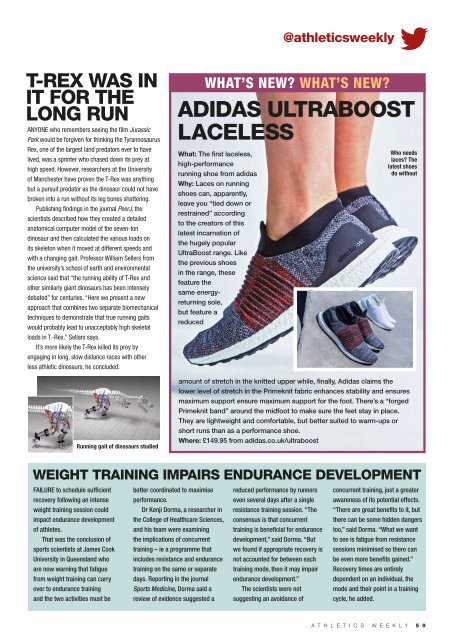Atheltics Weekly
Create successful ePaper yourself
Turn your PDF publications into a flip-book with our unique Google optimized e-Paper software.
@athleticsweekly<br />
T-REX WAS IN<br />
IT FOR THE<br />
LONG RUN<br />
ANYONE who remembers seeing the film Jurassic<br />
Park would be forgiven for thinking the Tyrannosaurus<br />
Rex, one of the largest land predators ever to have<br />
lived, was a sprinter who chased down its prey at<br />
high speed. However, researchers at the University<br />
of Manchester have proven the T-Rex was anything<br />
but a pursuit predator as the dinosaur could not have<br />
broken into a run without its leg bones shattering.<br />
Publishing findings in the journal PeerJ, the<br />
scientists described how they created a detailed<br />
anatomical computer model of the seven-ton<br />
dinosaur and then calculated the various loads on<br />
its skeleton when it moved at different speeds and<br />
with a changing gait. Professor William Sellers from<br />
the university’s school of earth and environmental<br />
science said that “the running ability of T-Rex and<br />
other similarly giant dinosaurs has been intensely<br />
debated” for centuries. “Here we present a new<br />
approach that combines two separate biomechanical<br />
techniques to demonstrate that true running gaits<br />
would probably lead to unacceptably high skeletal<br />
loads in T.-Rex,” Sellars says.<br />
It’s more likely the T-Rex killed its prey by<br />
engaging in long, slow distance races with other<br />
less athletic dinosaurs, he concluded.<br />
Running gait of dinosaurs studied<br />
WHAT’S NEW? WHAT’S NEW?<br />
ADIDAS ULTRABOOST<br />
LACELESS<br />
What: The first laceless,<br />
high-performance<br />
running shoe from adidas<br />
Why: Laces on running<br />
shoes can, apparently,<br />
leave you “tied down or<br />
restrained” according<br />
to the creators of this<br />
latest incarnation of<br />
the hugely popular<br />
UltraBoost range. Like<br />
the previous shoes<br />
in the range, these<br />
feature the<br />
same energyreturning<br />
sole,<br />
but feature a<br />
reduced<br />
Who needs<br />
laces? The<br />
latest shoes<br />
do without<br />
amount of stretch in the knitted upper while, finally, Adidas claims the<br />
lower level of stretch in the Primeknit fabric enhances stability and ensures<br />
maximum support ensure maximum support for the foot. There’s a “forged<br />
Primeknit band” around the midfoot to make sure the feet stay in place.<br />
They are lightweight and comfortable, but better suited to warm-ups or<br />
short runs than as a performance shoe.<br />
Where: £149.95 from adidas.co.uk/ultraboost<br />
WEIGHT TRAINING IMPAIRS ENDURANCE DEVELOPMENT<br />
FAILURE to schedule sufficient<br />
recovery following an intense<br />
weight training session could<br />
impact endurance development<br />
of athletes.<br />
That was the conclusion of<br />
sports scientists at James Cook<br />
University in Queensland who<br />
are now warning that fatigue<br />
from weight training can carry<br />
over to endurance training<br />
and the two activities must be<br />
better coordinated to maximise<br />
performance.<br />
Dr Kenji Dorma, a researcher in<br />
the College of Healthcare Sciences,<br />
and his team were examining<br />
the implications of concurrent<br />
training – ie a programme that<br />
includes resistance and endurance<br />
training on the same or separate<br />
days. Reporting in the journal<br />
Sports Medicine, Dorma said a<br />
review of evidence suggested a<br />
reduced performance by runners<br />
even several days after a single<br />
resistance training session. “The<br />
consensus is that concurrent<br />
training is beneficial for endurance<br />
development,” said Dorma. “But<br />
we found if appropriate recovery is<br />
not accounted for between each<br />
training mode, then it may impair<br />
endurance development.”<br />
The scientists were not<br />
suggesting an avoidance of<br />
concurrent training, just a greater<br />
awareness of its potential effects.<br />
“There are great benefits to it, but<br />
there can be some hidden dangers<br />
too,” said Dorma. “What we want<br />
to see is fatigue from resistance<br />
sessions minimised so there can<br />
be even more benefits gained.”<br />
Recovery times are entirely<br />
dependent on an individual, the<br />
mode and their point in a training<br />
cycle, he added.<br />
A T H L E T I C S W E E K L Y 5 9






